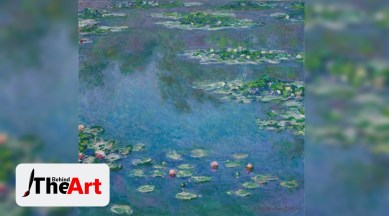📣 For more lifestyle news, click here to join our WhatsApp Channel and also follow us on Instagram
Behind the Art: What is the story behind Claude Monet’s Water Lilies?
Behind the Art: What is the story behind Claude Monet's "Water Lilies"? Why are they so famous?

French Impressionist Claude Monet changed the face of the art world through this Water Lilies series beginning between 1897 and his death in 1926. Through a series of approximately 250 oil paintings, he depicted his flower garden at his home in Giverny which were the main focus of his artistic production during the last thirty years of his life. Monet suffered from cataracts when many of his works were painted and are considered famous works of Impressionism along with Vincent van Gogh’s Starry Night. The paintings are prominently displayed in museums all over the world, including the Princeton University Art Museum, the Musée Marmottan Monet, the Musée d’Orsay in Paris, the Metropolitan Museum of Art, and the Museum of Modern Art in New York. One of the Water Lilies, Le Bassin aux Nymphéas, sold for $27 million on May 6, 2014, at Christie’s in New York City and in June 2014, one of the Water Lilies, Nymphéas, sold for $54 million at a Sotheby’s auction in London. But why is the Water Liles series so celebrated? What is the story behind it?
The story behind the Water Lilies series
Claude Monet once said, “One instant, one aspect of nature contains it all.” He was referring to his final masterpieces, the water landscapes he painted at his home in Giverny between the years 1897 and 1926. These works supplanted the different contemporary subjects he had painted from the 1870s through the 1890s with a solitary, immortal theme — water lilies. The beloved flower garden of the artist was the main focus of these paintings. It had a water garden and a smaller pond that was crossed by a Japanese footbridge. Monet painted the pond environment with its plants, bridge, and trees neatly divided by a fixed horizon in his first series of water lilies (1897–99). The artist became less and less concerned with standard pictorial space over time. He had already removed the horizon line by the time he painted Water Lilies, which is part of his third group of these works. Monet’s cataract was discovered when he was 82 years old. The artist wrote, “I realized with terror that I could see nothing with my right eye…” The deterioration in his eyesight horrified the artist. He was operated on three times in 1923 to attempt to correct his right eye. Water Lilies – Japanese Bridge, 1923’s fiery reds and yellows are an indication of the artist’s impaired vision as he views his bridge within a limited palette. However, it is the most evocative combination of colour, light, and composition, resulting in an astonishingly emotional effect.
Unknown Facts about the Water Lilies series
An interesting fact about the paintings is that Monet focuses on the water’s surface in each one of his “Water Lilies” paintings. He only shows their reflection in the water, omitting any representation of the land or sky. The willows only appear as a reflection in these paintings, which is typical. Because the water reflects the white clouds in the sky, both the sky and the water are the same shade of blue. The observer only becomes aware that this is a reflection when the water lilies are present. Another unknown fact is that before he painted them, Monet planted the water lilies. As if it were a colossal painting, Monet organised his Giverny property. He diverted a river and planted water lilies, exotic flowers, weeping willows, bamboo trees, and willows with the assistance of a small army of gardeners. He added white chicken, duck, and pheasant enclosures to the pond and seeded it. Monet’s work had always been cherished by Prime Minister Clemenceau. He urged the artist to work on a larger project in 1914, and 1916, the project became a formal state commission. This was for a set of large canvases with water lilies on them that would be displayed together for the rest of their lives. This was going to be the primary focus of Monet’s work from this point on until his death.
The significance and legacy
Abstract painting got its start thanks to water lilies. Monet and his circle were the first to challenge the conventions of Parisian art in the modern era, and by progressing their works toward a greater understanding of colour and light, they opened the door for subsequent generations of artists. By the time Monet died in 1926, the art world, both in Paris and in America, was a very different place from the one he had largely struggled against throughout much of his life. To achieve the freedom of expression that is now taken for granted, Monet and his contemporaries broke down barriers and persevered in their artistic pursuit despite great hardship. Monet set a precedent for subsequent artists, particularly those of the Post-impressionist, Expressionist, and Abstract-expressionist movements.
Next up in Behind the Art: Why is Wanderer above the Sea of Fog by Caspar David Friedrich considered one of the masterpieces of the Romantic movement?
📣 For more lifestyle news, click here to join our WhatsApp Channel and also follow us on Instagram